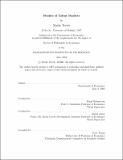| dc.contributor.advisor | Bengt Holmström and David Autor. | en_US |
| dc.contributor.author | Terviö, Marko | en_US |
| dc.contributor.other | Massachusetts Institute of Technology. Dept. of Economics. | en_US |
| dc.date.accessioned | 2005-05-19T15:18:29Z | |
| dc.date.available | 2005-05-19T15:18:29Z | |
| dc.date.copyright | 2003 | en_US |
| dc.date.issued | 2003 | en_US |
| dc.identifier.uri | http://hdl.handle.net/1721.1/16924 | |
| dc.description | Thesis (Ph. D.)--Massachusetts Institute of Technology, Dept. of Economics, 2003. | en_US |
| dc.description | Includes bibliographical references (p. 109-113). | en_US |
| dc.description | This electronic version was submitted by the student author. The certified thesis is available in the Institute Archives and Special Collections. | en_US |
| dc.description.abstract | This thesis consists of three studies of labor markets where differences in talent are associated with very large differences in income. The unifying theoretical feature is the view that the analysis of such labor markets should take into account the scarcity of jobs, which is a natural consequence of the combination of finite demand and positive production costs. In Chapter 1 we propose a model where an industry-specific talent can only be revealed on the job and publicly. Individual inability to commit to long-term contracts leaves firms with insufficient incentives to hire novices, inducing them to bid excessively for the pool of revealed talent instead. This causes the market to be plagued with too many mediocre workers, inefficiently low output levels, and excessive rents for the known high talents. We argue that high wages in professions such as entertainment and entrepreneurship may be explained by the nature of the talent revelation process in those markets, and suggest potential natural experiments for estimating the welfare loss and the excessive talent rents predicted by the model. Chapter 2 is an analysis of the labor market of CEOs. We present an assignment model of managers and firms of heterogeneous talent and scale, and show how the value of underlying ability differences can be distinguished from scale effects using the observed joint distribution of CEO pay and market value. The empirical results suggest that the observed size-pay relation in the US is mainly due to differences in firm characteristics rather than differences in managerial ability. Chapter 3 uses a combination of simple versions of the models of the first two chapters to analyze the role of transfer fees in professional sports. There workers are able to commit to long-term wage contracts, and a transfer fee is the price of a remaining contract. | en_US |
| dc.description.abstract | (cont.) We show that the abolition of transfer fees would reallocate playing time towards older players and increase salaries by more than the current transfer fees. All clubs, including the bigger clubs that are the current net payers of transfer fees, would lose out in the reform. | en_US |
| dc.description.statementofresponsibility | by Marko Terviö. | en_US |
| dc.format.extent | 113 p. | en_US |
| dc.format.extent | 572683 bytes | |
| dc.format.extent | 572385 bytes | |
| dc.format.mimetype | application/pdf | |
| dc.format.mimetype | application/pdf | |
| dc.language.iso | eng | en_US |
| dc.publisher | Massachusetts Institute of Technology | en_US |
| dc.rights | M.I.T. theses are protected by copyright. They may be viewed from this source for any purpose, but reproduction or distribution in any format is prohibited without written permission. See provided URL for inquiries about permission. | en_US |
| dc.rights.uri | http://dspace.mit.edu/handle/1721.1/7582 | |
| dc.subject | Economics. | en_US |
| dc.title | Studies of talent markets | en_US |
| dc.type | Thesis | en_US |
| dc.description.degree | Ph.D. | en_US |
| dc.contributor.department | Massachusetts Institute of Technology. Department of Economics | |
| dc.identifier.oclc | 52873542 | en_US |
